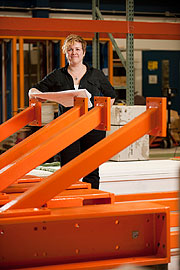MicroBooNE begins construction, elects co-spokesperson
 |
|
Fermilab physicist Jen Raaf manages the assembly process of pieces that will make the MicroBooNE detector. Photo: Reidar Hahn
|
Fermilab's neutrino experiment, MicroBooNE, is beginning the full construction phase for the detector, after DOE announced the official Critical Decision 3b approval on March 29.
"This is a significant milestone for the MicroBooNE project," said project manager Gina Rameika, noting that the next step in the DOE CD process will be CD 4, which is approval to start operations, planned for mid-2014.
In the last phase of the project, the MicroBooNE collaboration began acquiring precision-made parts for the detector from institutions like Brookhaven National Laboratory, Syracuse University and Yale University. Soon the team will begin assembling those pieces.
The inner time projection chamber, which will provide three-dimensional reconstructions of neutrino events, will soon begin assembly within the DZero building, a former experiment hall for the Tevatron. When this is finished, the 33-foot-long TPC will slide into a cryostat-cooling chamber and move to its new housing at the Liquid Argon Test Facility, currently under construction at Fermilab. Once there, scientists will begin tracking neutrinos with liquid argon, allowing high sensitivity for the experiment.
"We'll push the TPC into the cryostat, load it onto a truck and drive it really, really slowly to LArTF," said Jen Raaf, the physicist managing the assembly process. "It's like driving a school bus onto a wide-load tanker truck."
Also valuable to MicroBooNE's mission is the recent success of the Liquid Argon Purity Demonstrator. Purifying liquid argon is vital to neutrino experiments for maintaining precise measurements of particle interactions. Though the 170-ton tank will be capable of being evacuated – a more expensive way to maintain argon purity – MicroBooNE co-spokesperson Bonnie Fleming expects the new LAPD-based system to make that process unnecessary.
"As part of our development goal, we want to make sure that the next generation detector, beyond MicroBooNE, doesn't even have to have the option of being evacuable," she said.
The team is also developing the tools needed for data analysis, setting up the controls and preparing the particle beamline for operation.
In addition to DOE's announcement, the collaboration also named a new co-spokesperson, Fermilab physicist Sam Zeller. She was a co-coordinator for LArSoft, the group designing generic software capable of reconstructing detailed data from neutrino interactions in any liquid argon TPC. Zeller has also contributed to the ArgoNeuT, MiniBooNE and SciBooNE experiments.
"We have a fantastic team working to build MicroBooNE as quickly and as safely as possible so we can start taking neutrino data with this new device," Zeller said of the detector.
—Brad Hooker
|